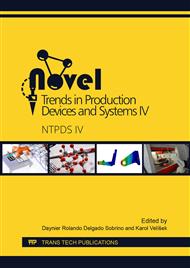[1]
Apeal, Oficiálna stránka asociácie európskych výrobcov ocele pre výrobu obalových materiálov Dostupné na internete: <http: /www. apeal. org/en/apeal/who-we-are>.
Google Scholar
[2]
V. Machek, Tenké ocelové pásy a plechy valcované za studena, STNL, Nakladatelství technické literatury, Praha, (1987).
Google Scholar
[3]
J. Majerníková, Medzné deformácie tenkých obalových plechov pri rôznych napäťovo-deformačných stavoch. Dizertačná práca, Košice, (2008).
Google Scholar
[4]
F. Stachowicz, Effects of microstructure on the mechanical properties and limit strains in uniaxial and biaxial stretching, Journal of M.W.T., 19, (1989), 305-317.
DOI: 10.1016/0378-3804(89)90080-6
Google Scholar
[5]
E. Spišák, J. Majerníková, Analysis of variance of mechanical properties of sheets as the input parameters for simulation ofprocesses, Acta Metallurgica Slovaca. Roč. 18, č. 2-3 (2013) 109-116.
Google Scholar
[6]
X. Wang, Z. Zhu, F. Cai, H. Li, Effects of continuous annealing process on microstructure and properties of electrolytic tinplate, Heat Treatment of Metals. Vol. 38 (6), (2013) 49-54.
Google Scholar
[7]
B. Wang, Q.D. Zhang, M. Yu, X.F. Zhang, G.H. Ni, Description and Control of Tin Plate Surface Visual Quality, Advanced Materials Research. Vol. 145 (2010) 510-515.
DOI: 10.4028/www.scientific.net/amr.145.510
Google Scholar
[8]
E. Spišák, J. Slota, J. Majerníková, The evaluation of mechanical properties of tinplates as input parameters for simulation of deep drawing processes, Metalurgija. Vol. 49, No. 2 (2010) 528-532.
Google Scholar
[9]
P.V. Makarov, Simulation of elastic-plastic deformation and fracture of materials at micro-, meso- and macrolevels, Theoretical and Applied Fracture Mechanics, 37, (2001), 183-244.
DOI: 10.1016/s0167-8442(01)00078-7
Google Scholar
[10]
D. Gade, Tribological behaviour of tinplate during ironing, Metal buletin and Tinplate Technology, 8th International Tinplate Conference, Paris (2004).
Google Scholar
[11]
B. Barisic, T. Pepelnjak, K. Kuzman, Numerical-stochastic modeling and simulation of deep drawing tinplates rings, Advanced Materials Research, 6-8, (2005), 329-336.
Google Scholar
[12]
E. Spišák, J. Slota, J. Majerníková, Analýza priebehu deformácie jednoducho a dvakrát redukovaných obalových plechov, Chemické listy. Vol. 105, no. S (2011) 485-487.
Google Scholar
[13]
E. Spišák, J. Slota, J. Majerníková, Ľ. Kaščák, P. Malega, Inhomogeneous plastic deformation of tinplates under uniaxial stress state, Chemické listy. Vol. 106, no. Symposia (2012) 537-540.
Google Scholar
[14]
S. Kalpakjian, S.R. Schmid, Manufacturing Engineering and Technology. Fourth Ed. Prentice Hall. Upper Saddle River, NJ USA. (2001).
Google Scholar
[15]
J. Hilden, K. Lewis, A. Meamaripour, Selvaduray G. Measurement of Springback Angle in Sheet Bending. Submitted to 11th Annual National Educators' Workshop. San Jose State University, Department of Materials Engineering, San Jose, CA 95192-0086, USA.
DOI: 10.5614/ejgta.2019.7.1.1
Google Scholar


